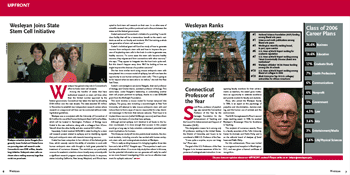Wesleyan Joins States Stem Cell Initiative
 Wesleyan has gained a key role in Connecticut’s effort to foster stem cell research.
Wesleyan has gained a key role in Connecticut’s effort to foster stem cell research.
Among the handful of states that have authorized research on stem cell lines other than the limited number approved by the federal government, Connecticut has taken the lead by allocating $100 million over the next decade. The state awarded $5 million in November to establish two independent research centers where research on unapproved cell lines can be conducted without violating federal guidelines.
Wesleyan was a corecipient with the University of Connecticut of $2.5 million for one of the Human Embryonic Stem Cell Core Facilities, which will be located in Farmington. Professor of Biology Laura Grabel is the new codirector, along with a colleague from UConn. Yale will direct the other facility and also received $2.5 million.
Separately, Grabel received $878,000 in state funding for a stem cell research project related to epilepsy and to identifying signals that push embryonic stem cells towards becoming neurons.
Grabel has been outspoken in her criticism of the federal guidelines, which severely restrict the ability of scientists to work with human embryonic stem cells thought to hold great potential for treatment of numerous diseases. The restrictions are particularly onerous for academic scientists since virtually every university with a significant research program receives federal funds. In response, states including California, New Jersey, Maryland, and Illinois have opted to fund stem cell research on their own. In no other area of scientific research has politics produced such a fissure between the states and the federal government.
Grabel welcomed Connecticut’s initiative for providing “a worldclass facility that will be a tremendous benefit to the state’s residents as well as our faculty and students. We“ll be training a whole new generation of stem cell researchers.”
Grabel“s individual grant will fund her study of how to generate neurons from embryonic stem cells and how to improve the process of implanting stem cells in the brain in order to generate new, healthy neurons. “In some cases the stem cells become healthy neurons; they migrate and form connections with other neurons,” she says. “They appear to integrate into the host brain quite well. But this doesn’t happen every time. We’ll be looking at how we might improve the chances of a positive outcome.”
She has done similar work using mouse embryonic stem cells transplanted into a mouse model of epilepsy, but will now have the opportunity to use human embryonic stem cells. “This is going to be far beyond what we were able to do before,” she told the New York Times.
Grabel’s coinvestigators are Janice Naegele, chair and professor of biology, and Gloster Aaron, assistant professor of biology. This same team, under Naegele’s leadership, is undertaking another stem cell project pertinent to epilepsy, thanks to a new $300,000 grant from the McKnight Foundation.
This work involves a mouse model for human temporal lobe epilepsy. The group, also including a neurobiologist at New York University, will attempt to take mouse embryonic stem cells and induce them to form a type of neuron responsible for a key chemical messenger in the brain that reduces seizures. Their hope is to implant these neurons (called GABAergic neurons) and have them function in the brains of mice that have epilepsy.
Although animal epilepsy isn’t identical in all facets to the human counterpart, it is close enough that success in this project would go a long way to help scientists understand potential treatment implications for humans.
This three-year study will involve postdoctoral students, five doctoral students, including one who has worked with human embryonic stem cells, and undergraduate students at Wesleyan.
“This is really exciting because it is bringing together three labs here and a lab at NYU,” Naegele says. “The expertise in each complements the others. It’s a more risky study than others in this area, but the potential information we can generate will really be useful as we move forward investigating if this can be an effective treatment for epileptic seizures.”
